Summary of Cave Art
Cave Art (or Paleolithic Art) is a broad term for the earliest known art-making in human history. This movement is perhaps best-known today for the paintings found on the walls of many prehistoric caves, rich in depictions of animals, human figures, and forms that are a combination of man and beast. The tradition of cave art also includes relief carvings and portable sculptural objects. The art created by our earliest ancestors is at one level alien and deeply mysterious to us, and yet it serves as a reminder of the common humanity we share with its creators. It rarely fails to dazzle and astound with its meticulous detail, abstract gestures, and rich scope for imaginative speculation on its meaning and origin.
Key Ideas & Accomplishments
- The art made during the Paleolithic era is the only document left to us by prehistoric people of their lives. For this reason, it is both vitally important and steeped in mystery, with no written records to accompany or explain it. Archaeologists, historians, and scholars have for centuries attempted to decode the motivations behind cave art, but all we can confidently assume is that these images and objects must have held great importance given the time dedicated to creating them, particularly given the nomadic lifestyles that held sway in this era.
- Paleolithic art is found throughout the world and on every continent except Antarctica. However, the most researched and well-known examples have come from Europe. According to archaeologist Bruno David, the cave art of France and Spain "has reached especially great fame over the past century, capturing the imagination of the general public as well as attracting the attention of archaeologists. "
- Paleolithic art was made with the limited materials that were available at the time. This includes natural pigments such as ochre and charcoal applied to cave walls by using plants or the artists' hands as brushes. Mixtures and powders would also have been blown onto walls through reed-like tubes or using the mouth, while portable objects were often carved out of animal tusks such as those of mammoths, using pieces of flint or rock.
- There are key differences between the cave art traditions of different regions, suggestions different functions or influences for cave art dependent on geography. European images, for instance, rarely ever feature a human and almost always depict animals. The majority of human representations that are found on other continents, most notably in Africa and Australia.
Overview of Cave Art
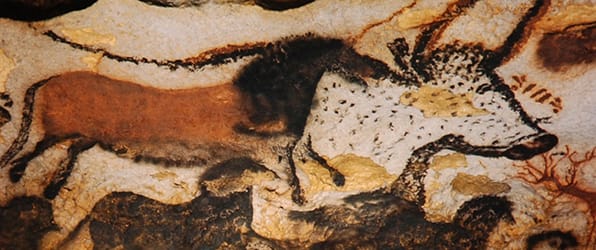
Paleolithic art is a broad term used to describe the earliest known art making period in the history of human development, including cave paintings, relief carvings and sculptural objects. The artwork of this period is steeped in mystery. Theories around its creation range from ceremonial and religious concepts to mapping or educational uses.
Artworks and Artists of Cave Art

Lion-man of the Hohlenstein-Stadel
This impressive 12-inch composite creature, carved from the ivory of a mammoth, fuses animal and human elements. Its beastly attributes include a lion's head and the elongated body and forelimbs of a big cat, while the legs, feet and bi-pedal stance are clearly modeled on the human form.
An important prehistoric work, the sculpture was discovered in Germany in the Hohlenstein-Stadel cave in 1939 and is the oldest example of an imaginary form in history. The fact the work is a composite creature emanating from the artist's mind disproves any notion that the earliest humans were unintelligent or unimaginative, while the time involved in its creation also suggests a capacity for sustained and concentrated thought. According to author Jill Cook, "an experiment by Wulf Hein using the same sort of stone tools available in the Ice Age indicate that the Lion Man took more than 400 hours to make... This was a lot of time for a small community living in difficult conditions to invest in a sculpture that was useless for their physical survival. "
Whilst we may never know the reason this work was created, the time spent on it in an age of nomadic hunter-gatherer routines is proof of its importance to the individual or community concerned. According to Cook, "the Lion Man makes sense as part of a story that might now be called a myth. The wear on his body caused by handling suggests that he was passed around and rubbed as part of a narrative or ritual that would explain his appearance and meaning. It is impossible to know what that story was about or whether he was deity, an avatar to the spirit world, part of a creation story or a human whose experiences on a journey through the cosmos to communicate with spirits caused this transformation." "Perhaps this hybrid", she concludes, "helped people to come to terms with their place in nature on a deeper, religious level or in some way to transcend or reshape it. "
Ivory - Collection of Museum Ulm, Germany
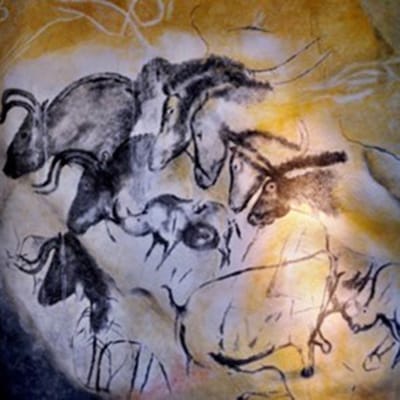
Panel of Horses
Known as the Panel of Horses, this painting found in the Chauvet cave in fact features nineteen other types of animals, including deer and rhinoceroses, as well as its famous equine subjects in side profile. This beautiful and elaborate frieze is one of the most significant works in the Chauvet complex. As well as providing an important historical record of the animals that existed in prehistoric France, this painting gives a sense of the detail and realism with which early artists could capture the world around them.
The sophistication of technique, including figurative detail and perspective, characterizing the pieces at Chauvet has been frequently discussed. According to writer James C. Harris, the Chauvet drawings "are highly realistic, and many show perspective and utilize the contours in the cave wall, sometimes to suggest movement." F ocusing on the Panel of Horses, he notes "the presence [of] rhinoceroses at the bottom of this panel", with "small arched ears, crossed horns, and leg positions suggesting movement. Meanwhile, "the heads of the four horses in this panel most powerfully engage the viewer...The one showing the greatest detail [with] its open mouth suggests the horse is whinnying. "
The early artistic technique of stump drawing is evident in this painting. As archaeologist Jean Clottes explains, here, "the artist has crushed charcoal and mixed it with the soft whitish substance that covers the walls to obtain shades that range from black to dark blue, and he (or she) has skillfully spread the pigment inside the head and the body [of the horses] to create their contours, using the process currently known as 'stump drawing. '" Like many other works of ancient cave art, The Panel of Horses offers extraordinary insight into minds set far apart from ours in time yet sharing certain vital emotional, social, and creative instincts.
Pigment on rock - Chauvet cave, Ardèche Valley, France
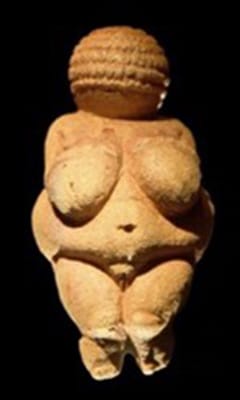
Venus of Willendorf
Perhaps the most well-known work of three-dimensional art from the Paleolithic period, the Venus of Willendorf is a sculpture of a woman with exaggerated female features including breasts, hips, and pubic area. A small work, measuring little more than four inches high, the statue has no distinguishing features other than a head full of coiled rows of hair, suggesting an archetypal character, perhaps meant to sum up certain principles of femininity or fertility, rather than an individual human being.
This work, discovered in Austria in 1908, is amongst several carved female figurines uncovered in caves across Europe. Their small size means the works were portable, contributing to debate over their intended purpose. As archaeologist Bruno David explains, these figures "have provoked many different interpretations ranging from children's dolls to 'mother goddesses'. They have been thought by some commentators to have acted as symbols of fertility in a harsh Ice Age environment where fecundity was highly valued, by others as images of women's bodies by and for men, and by others again as self-representations by women, or as obstetric devices to monitor the growth of the foetus and to aid with childbirth, or as a standardized way of stylized depiction to facilitate information exchange between communities. "
The documentation of the "Venus" figures is also an interesting example of the potential pitfalls of titling works after the fact. David asserts that these figures "have become a useful way of exposing the sociology of our own Western biases. " We think of Venus as the Greek goddess of love, and so by giving these works such a title we imply, with no basis in fact, that there is a sexual element to the figures. According to author Joshua Learn, "some experts believe they represent everything from self-depictions of women to ancient pornography. But many of these interpretations have now been discredited for the inherent sexism they carry." These interpretations were probably given extra currency by the "Venus" tag.
Limestone with red ochre - Collection of Naturhistorisches Museum, Vienna, Austria
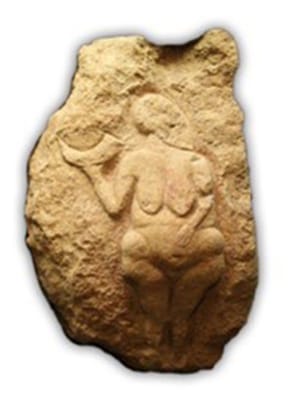
Venus of Laussel
The so-called Venus of Laussel is an 18-inch bas-relief carving featuring a woman with large breasts and hips. Her left hand rests on her stomach while in her right hand she holds a carved horn (most believe that of a bison) on which are carved thirteen lines. While her face contains no distinguishing features, she appears to be turning her head to the right as if to look at the horn.
Arguably the most famous of the five carvings found amongst the cave painting treasures discovered in the Laussel Cave in the Dordogne Valley of France in 1911, this work has been the source of extensive debate over its meaning. As with the Venus of Willendorf, discussions around the provenance and significance of the object tell us as much about the eras in which different theories were advanced as the age in which the artwork was created. Many contemporary commentators have noted the sexism implicit in the assumption that works placed in the "Venus" category carry some sexual charge.
Nonetheless, the most accepted interpretation of this work is that as one of several depictions of females with exaggerated breasts and pubic areas, this female form represents an archetype of feminine fertility. As author K. Kris Hirst explains, some scholars have gone so far as to argue that what she is holding "is not a horn core, but rather an image of the crescent moon, and the 13 stripes cut into the object are an explicit reference to the annual lunar cycle. This combined with the Venus resting her hand on a large belly, is read as a reference to fertility, some speculate that she is illustrated as pregnant. The tallies on the crescent are also sometimes interpreted as referring to the number of menstrual cycles in a year of an adult woman's life. "
Limestone with red ochre - Collection of Museum of Acquitaine, Bordeaux, France
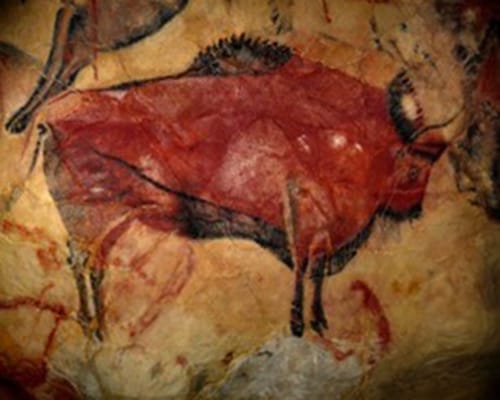
Altamira Bison
This image of a bison is part of a large number of animals depicted in the Altamira cave. Painting the beast in side-profile, the artist has gone to great efforts to make the animal as detailed as possible, including distinguishing features such as horns, hooves, and tufts of hair. Pablo Picasso's bulls and other larger animals are often reminiscent of the bison of Altamira, and it is known that images like this had a profound effect on the painter's imagination.
Painted on the ceiling, bison are the most frequently depicted animal in the Altamira complex, with this being one of the finest examples. A distinguishing feature of the art found in the Altamira cave is the striking use of color to represent fauna, the deep orange of the animal's side still vivid thousands of years later. This is a result of the vibrant red ochre pigment used to both outline the bison and to fill in its flank.
Interestingly, the bison does not appear in relation to any landscape, rather seeming to float free amongst the other animals. This leads to questions regarding the purpose behind its placement. Whilst we will probably never know the answers to these questions, possible theories include that the animal was merely decorative, that it served as a teaching tool, and that it was used during religious ceremonies in the cave, during which people would gaze up in wonder at the illuminated ceiling.
Pigment on rock - Altamira cave, Cantabria, Spain
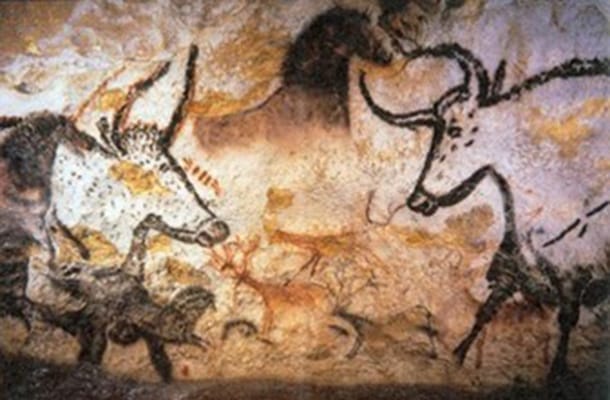
Hall of Bulls
The Hall of Bulls is a painting featuring a large number of prehistoric animals, including bulls, horses, aurochs, and deer. Placed on a large segment of rock in the interior of the Lascaux cave, the animals are presented in different degrees of detail and size, suggesting that the drawing was created by multiple people, potentially over an extended period of time.
The Lascaux cave, one of the most impressive in the Paleolithic period, features many different paintings across several chambers. The area known as the Hall of Bulls is important because it supports the view that certain areas in ancient caves were used as gathering places for spiritual rituals or ceremonies. According to archaeologist Jean Clottes, the Hall of Bulls "would have been able to accommodate relatively large groups. The drawn or painted images are detailed, sometimes complex, and of considerable size. They are visible from a distance...This suggests participation in collective ceremonies, which might have been frequent or rare. These meticulously prepared and very visible images might have played a social role in the celebration of rites, in the perpetuation of beliefs and of perceptions of the world and in recruiting the aid of invisible powers. "
A noteworthy feature of this painting is that all the animals appear to be moving, many of them even charging towards each other. This contributes to the mystery of the panel and raises questions as to whether it could represent a particular event, or used as a teaching tool to show all the animals in the area which would be available for hunting.
Pigment on rock - Lascaux cave, Montignac, France
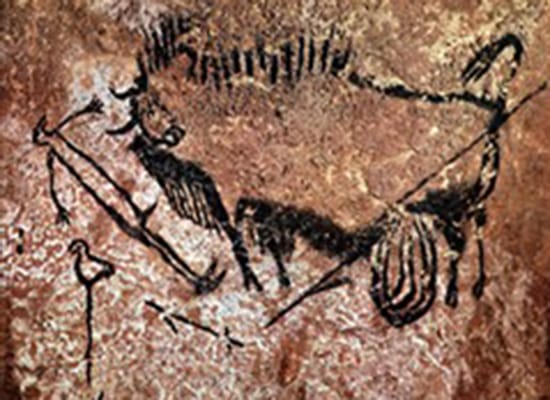
Male figure with bird head and disemboweled bison
In this painting found on the walls of the Lascaux cave, a creature is depicted with a male body and the head of a bird. To the left of the figure is a stick, perhaps a spear, on which is perched a bird. To the right is a large bison whose intestines have been pulled from its body. Commonly referred to as the "bird man" panel, this painting is a rare example of a figure drawing from Paleolithic Europe, where non-human animals are much more frequently found.
Debate surrounds the intended meaning of this painting, as archaeologist Bruno David articulates: "are these examples of rituals, religious performances that involved people wearing masks and, in the case of the 'bird-man' of Lascaux, associated with a kind of bird wand?" We know that the figure is a composite creature, which many scholars have associated with religious or mythical functions, making such an assumption possible. Other parts of the drawing are even more mysterious. The bird man's erect penis begs the question of whether there is a sexual meaning attached to the work, potentially connected to its religious role.
Other explanations have also been forwarded, however. The fact that an injured bison appears next to the figure has led some to consider the drawing a symbol or talisman to ensure a productive hunt. There is also debate as to whether the birdman and bison are related at all. Were they simply placed next to each other at random; were they even drawn at the same time, or by the same person? Such discussion typifies the mystery that surrounds cave art, which does nothing to lessen its appeal to modern audiences.
Pigment on rock - Lascaux cave, Montignac, France
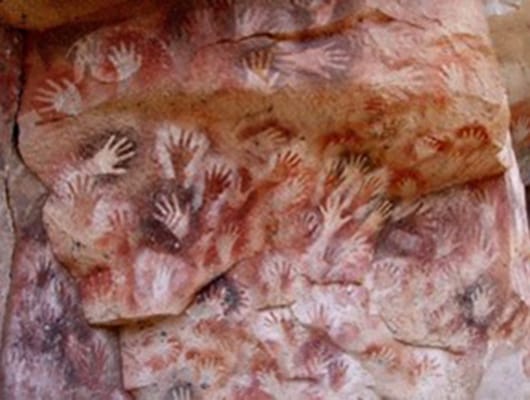
Hand stencils
In the aptly named Cave of the Hands a collection of handprints is stenciled onto the cliff wall in red, black, and white pigments. As author Nick Dall explains, "of the 829 handprints most are male, one has six fingers and only 31 are of right hands. All of the prints are negatives or stencils; created by placing the hand against the rock face and blowing paint at it through a tube made of bone. " One of the most striking aspects of the artwork is the way that form and background colors switch, such that the color of a hand in one section reappears as the base color - behind the hand - in another.
When we look at this ancient rock art, we are inevitably led to wonder what caused our ancestors to mark their presence in this way. Dall offers two possible explanations. "[O]ne of the more plausible theories is that the hands were painted by adolescent boys as part of an initiation ceremony or rite of passage. This is backed up by the fact that many of the handprints are not large enough to have been made by fully-grown adults. Another popular theory is that the paintings were made as part of a religious ceremony that preceded a hunt. "
Whatever the explanation for their presence, these handprints are amongst the most extraordinary of all ancient artworks. Whereas other Paleolithic symbols and figures depict a life of hunting and nomadic wandering that feels distant to us, we share the basic features of our bodies - the shapes of our hands, for example - in common with our earliest ancestors. Indeed, there is no aspect of this image that could not have been created in the recent past, particularly given our modern preoccupation with abstract forms and gestures. Thousands of years of history seem to dissolve as we gaze at the walls of Cueva de las Manos.
Pigment on rock - Cueva de las Manos, Perito Moreno, Argentina
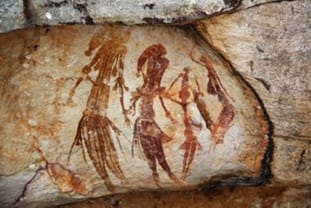
Gwion rock paintings
These Gwion rock paintings depict figures with elongated bodies. Elaborately dressed, many wear what appear to be feathers, tassels, and headdresses. A majority of the figures carry objects including spears and boomerangs. These are amongst a large number of images dotted across 100,000 sites veering 50,000 square kilometers of north-west Australia's Kimberley region. First discovered in 1891 by agriculturalist Joseph Bradshaw, the Gwion paintings constitute a whole tradition or school within Australia's rich history of ancient rock painting.
According to author Candida Baker, the Gwion paintings are among the most mysterious of Australian rock drawings due to the unusual appearance of the figures, with their many ornaments and appendages. Baker notes that these paintings are "quite different to any other known Australian rock art". She also comments on the unusual sophistication of the images, which seems to appear fully-formed in the earliest pieces created in this tradition, whereas normally we would expect such intricacy of effect to evolve over time. Baker cites Maria Myers, Chair of the Kimberley Foundation Australia (KFA), who notes that, in the case of Gwion paintings, "the first iteration of the art is the most sophisticated and beautifully painted, which suggests that whoever did the art was portraying a developed culture. "
Discoveries such as the Gwion rock paintings go a long way to disprove assumptions that prehistoric peoples were unsophisticated and underdeveloped. They suggest that the societies that produced rock art were capable of elaborate systems of social coding and stratification through dress, ornament, and figurative art.
Pigment on rock - Kimberley, Australia
Beginnings and Development
Earliest Humans to Make Art
It is impossible to state exactly when Homo sapiens (modern humans) began to create works of art, but famous examples date back to at least 40,000 BCE. However, the oldest known cave art was actually created by Neanderthals (Homo neanderthalensis), a species closely related to us, in around 63,000 BCE. Other excavated objects date from still earlier, but are the subject of debate as to whether they simply resemble crafted objects by chance.
A good example of the latter dilemma is the discovery of fossil sponges dating back to approximately 62,000 years ago, during the era of two early human species, Homo erectus and Homo heidelbergensis (the latter sometimes recorded as a subspecies of the former). Many of these sponges were discovered with holes running all the way through. Some archaeologists believe these holes were made intentionally and that the sponges were strung together, while others believe they are naturally occurring, or that the holes simply developed over time as a result of age and deterioration. If these holes were intentionally made and the sponges then strung together and presumably worn, than this would be the earliest examples of beads and an attempt by an early species at ornamentation and decoration of their bodies.
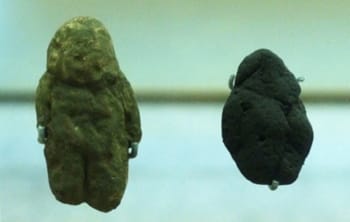
Two other early objects subject to a similar debate are the Tan-Tan figurine found in Morocco, dating to 50,000-30,000 years ago, and the 20,000-year-old Berekhat Ram figurine excavated in Israel. Both objects can be traced back to the Homo erectus or Homo heidelbergensis groups and suggest the appearance of a simplified human figure, but may have naturally assumed that shape. If they were created, then it supports an argument that species of human older than Homo sapiens had advanced minds and aesthetic inclinations.
Dating Paleolithic Art
Authenticating the year that Paleolithic art was made created immediate challenges for archeologists, and even today it can prove difficult to secure consensus amongst scholars. The greatest aid to the process has been through the use of carbon dating from the 1990s onwards. According to archaeologist Bruno David, "carbon dating is [today] the most commonly used method of absolute dating in cave art research, because some artworks contain organic carbon in such materials as charcoal or beeswax that can be reliably dated. "
However, even carbon dating is not always reliable in this context. As David continues, "caution is needed, as black charcoal drawings [found in a cave], for example, could have been done with old pieces of charcoal that had lain on the ground surface for long periods of time." In the theoretical example given, the age of the charcoal would be greater than that of the painting, making verified dating difficult.
Concepts and Styles
Cave Paintings
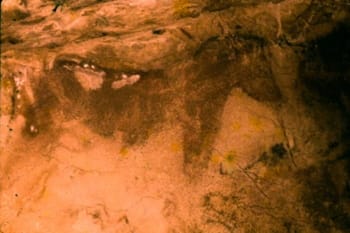
The most widely known form of Paleolithic art is probably the creation of paintings on prehistoric cave walls and ceilings. In many cases, even the discovery of these drawings is steeped in intrigue and excitement. For example, the famous depictions of bison and other animals in the Cave of Altamira in Spain were discovered in 1878 by Marcelino Sanz de Sautuola and his young daughter Maria while they were walking the grounds of their vast property. At the time of discovery, French experts questioned the authenticity and date of the paintings, perhaps in part out of jealousy that the cave was not in their own country. It was not until two decades later that the paintings were officially recognized by the archaeological community.
The discovery of the Lascaux cave was also the result of a fortuitous accident. In 1940, when France was under German occupation during World War Two, seven young boys were out walking their dogs when they discovered the opening to the cave on the property of the Count of La Rochefoucauld (they were trespassing at the time). Burrowing their way through a partially revealed opening, they entered the cave and, after exploring its depths, found themselves in the beautifully painted cavern today known as the Hall of Bulls. The boys had unwittingly stumbled on one of the most important prehistoric sites in the world.
Once similar ancient caves began to be discovered all over the globe, archaeologists and explorers unearthed a full range of often beautifully rendered animals and figures. Using charcoal and other natural pigments such as ochre, the early artists of the Paleolithic period transferred the drawings onto the cave walls by hand, often with the aid of simple brushes made of leaves or by blowing pigment through tubes of reeds.
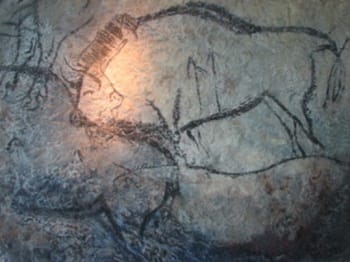
Great debate and mystery surrounds the creation of these cave paintings. Prehistoric humans were nomadic, traveling from place to place, and so the fact that they based themselves in single locations long enough to create these extraordinary likenesses imbues them with undeniable importance even if we will never know the artists' intentions. At the very least, the figures provide a good record of the types of animals that existed in certain locations during the Paleolithic age, some of which are extinct today. The representation of wild beasts has also led many to believe that the paintings served as records of the fauna available for hunting in the nearby area. The appearance of dots alongside some of the animals, meanwhile, may imply some sort of tally or count, implying that the works could have been used to record the success of previous hunting trips.
The frequent placement of these drawings high up on cave walls or even on ceilings, generally in remote areas towards the rears of caves, has led to other theories as to why some of these paintings were made. Effort would have been required to reach many artwork sites, and as they often appear above or alongside wide-open spaces, some believe the drawings were placed where groups could have gathered for secret or guarded ceremonies, perhaps in an attempt to will a good hunt. In the Niaux cave in France, for example, according to archaeologist Jean Clottes, "the comparatively vast chambers would have been able to accommodate relatively large groups." This supports the theory of the drawings having a ritual function.
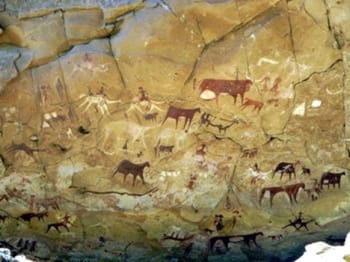
There are also important distinctions to be made between the cave paintings found in different parts of the world. Very few images of the human forms other than the occasional composite creature (half human, half animal) are found in the caves of Europe. As author Justin E. H. Smith notes of European cave art, "Paleolithic artists were singularly interested in the nonhuman mammals with which they shared an environment...Unlike Australian and southern African art from the same broad period, cave art in Europe offers no depiction of landscape, no horizon, no vegetation, almost no depiction of human-animal interaction, almost no hunting scenes."
By contrast, figures appear regularly in the cave art of Australia and Africa. There is no known reason for this. However, many people tend to attach a clearer religious function to non-European cave art, even suggesting that images could be documents of shamanic or religious ceremonies.
Paleolithic Sculptures and Portable Art
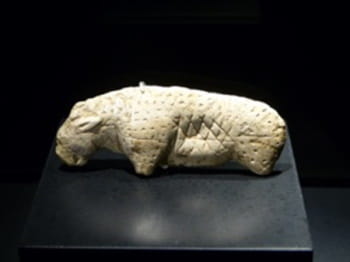
In addition to cave paintings, the Paleolithic period boasts a rich variety of sculptures and portable art (small objects that could be carried from place to place). Works from this period includes representations of the human form, most notably a number of "Venus" statues featuring women with enlarged breasts, hips, and pubic areas; animals such as a lion carved from mammoth ivory found in the Vogelherd Cave in Germany (40,000 years old); and composite creatures such as the "lion-man" of the Hohlenstein-Stadel (40,000 years old).
As the earliest humans did not live in settled communities, their three-dimensional artworks had to be small enough to carry with the pack as it traveled from place to place. Early humans also had access to only the crudest and simplest tools, such as pieces of flint, which they used to work on relatively tough materials such as ivory. The painstaking care taken to create these pieces supports the belief that they must have been of great significance to prehistoric people.
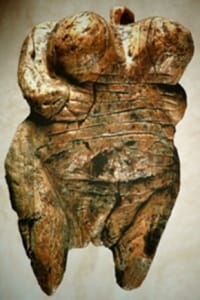
Many different theories exist as to why portable artworks were made during the Paleolithic era. According to K. Kris Hirst, "during the mid-twentieth century, archaeologists and art historians explicitly connected portable art to shamanism. Scholars compared the use of portable art by modern and historical groups and recognized that portable art, specifically figural sculpture, was often related to folklore and religious practices." Hirst goes on to speculate on other theories, noting that, while "a spiritual element may well have been involved with portable art objects...wider possibilities have since been put forward by archaeologists and art historians." These include the idea of "portable art as personal ornamentation, toys for children, teaching tools, or objects expressing personal, ethnic, social, and cultural identity. "
Composite Creatures and Religious Expression
One of the most fascinating aspects of Paleolithic art is the creation of painted and sculpted composite creatures. Sometimes referred to as therianthropes, these forms combine certain human features with other, animal characteristics. While not a common occurrence in cave art or ancient sculpture, enough of these animal-human hybrids have been discovered to support the idea of their importance to people of this era.

Notable examples of composite creatures in Paleolithic art include the "lion-man" of the Hohlenstein-Stadel (40,000 years old), the "bird man" panel in the Lascaux cave (16,000-14,000 BCE), and the figures found in San (Bushman) rock art in South Africa, including a male figure with the head and hooves of an antelope, holding on to the tail of a large beast. The depiction of imaginary creatures suggests a highly developed frame of mind and creative faculties amongst many early humans. These artists were not only interested in capturing what they saw in the world around them, but also in forging new worlds and sharing them with their communities, an urge that connects artists of all eras.
The biggest mystery surrounding these composite creatures is around their community function. Many believe that they had some kind of religious significance, and may have been depicted during ceremonies or rituals. According the Bradshaw Foundation website, "some archaeologists believe that therianthropes represent humans wearing costumes such as masks, antlers and animal skins. This may be true literally, but the fact that the practice appears to be so universal [with composite creatures found in caves all over the world and not limited to one geographic location] suggests that it is also true figuratively; it is a metaphor that represents the ancient belief involving the permeability of boundaries between the human and animal worlds. This belief allowed people to pass from one domain to another. Humans could be endowed with the qualities and characteristics of a particular animal species."
Further Developments
As our world continues to be explored, there is still the possibility of more Paleolithic art discoveries being made. A cave unearthed on the remote Indonesian Island of Sulawesi in late 2019 suggests the range of finds. As Katherine J. Wu explains, within the cave was discovered "a red-tinted painting depicting what appears to be a vivid hunt or ritual. In the scene, two wild pigs and four anoas, or dwarf buffaloes, scurry about as their apparent pursuers-mythical, humanoid figures sporting animal features like snouts, beaks and tails-give chase, armed with rope- and spear-like weapons. " With some historians ready to date the artwork as 44,000 years old, it could be one of the oldest cave paintings ever discovered, although there is already debate over the age of the piece amongst scholars.
With the excavation of ancient artistic sites occurring over centuries, theories as to their provenance and role have changed along with social mores. Justin E. H. Smith notes, for example, that "the first French scholars of cave art were mostly abbots and priests, and they saw their work as contributing to the vast project of Catholic apologetics...Their explicit concern was to find, in the symbolic world of early inhabitants of the continent that would much later become Europe, evidence for an awareness of the existence of a higher realm beyond the senses, and thus of a mental and spiritual capacity that could eventually accommodate the truth of Christianity. Over the twentieth century the discipline would develop into a proper science." Today, there is a wide range of theories as to the function of Paleolithic art, ranging from teaching and storytelling to the ideas of religious significance, mapping and even hunting tallies already noted.
Cave art has, in any case, played an important role in the advancement of theories around mental evolution during early human history. Bruno David notes that "cave art, both as buried portable objects such as personal adornments and as designs on rock walls, plays a key role in scientific debates concerning the degree to which cognitive modernism evolved with, or independently of, biological modernism. One reason for this is that artistic expressions are 'proxies' for aesthetically loaded forms of representational behaviour, for the ability to simulate and think in abstract ways that also tap into senses of appeal. "
The documentation of Paleolithic art has also allowed for increasingly sophisticated technologies to be tested and utilized. Initially, sketches and tracings had to be made on site, but scientific developments soon allowed more accurate reproduction. According to David, "one of the most complex but rewarding ways of documenting a site and its art is by making a high-precision three-dimensional digital model. At the Chauvet Cave, the French government not only commissioned such a three-dimensional recording, but then used it to physically build a life-sized model of much of the cave so that the public can see what the underground space looks like without detrimental effects to the original cave itself. "
Legacy
With the development of Modernism during the early-twentieth century, many artists became interested in ideas of untutored creative purity, leading to a new wave of fascination with cave art. Pablo Picasso reportedly visited the famous Altamira cave before fleeing Spain in 1934, and emerged saying: "Beyond Altamira, all is decadence. " Since then, artists including Picasso's fellow Cubist Amédée Ozenfant and the French Tachiste painter Pierre Soulages have spoken of their fascination with ancient painting and sculpture, and its influence on their practice. The British figurative painter Jenny Saville, meanwhile, has spoken of the influence of the Venus of Willendorf on her visceral depictions of female flesh.
Formal and thematic traits reminiscent of cave art can be found across a number of modern and contemporary art movements, from Cubism to Abstract Expressionism, and Art Brut. Picasso's depiction of bulls and other animals is frequently reminiscent of the elementary line and shape of Altamira's beasts, while Jackson Pollock explicitly honored ancient cave artists by leaving handprints along the top edge of at least two of his paintings. Jean Dubuffet sought to emulate the most instinctive and unschooled creative gestures through his work in ways that often brought to mind the art of the earliest human societies.
Land artists such as Giuseppe Penone, meanwhile, have brought a scale and primitivism of gesture reminiscent of cave art to much of their work. Penone's Sculptures of Lymph (2007), for example, involved covering walls with tanned leather molded to the shape of tree bark, suggesting the texture and atmospherics of the painted cave wall. The argument can even be made that Graffiti art has its roots in the early cave paintings and the leaving of one's mark on a wall traces back to the hand stencils made by the earliest humans.
Useful Resources on Cave Art
- Cave ArtOur PickBy Bruno David
- Dawn of Art: The Chauvet Cave (The Oldest Known Paintings in the World),By Jean-Marie Chauvet and Eliette Brunel Deschamps
- The Cave Painters: Probing the Mysteries of the World's First ArtistsBy Gregory Curtis
- What is Paleolithic Art? Cave Paintings and the Dawn of Human CreativityOur PickBy Jean Clottes
 Ask The Art Story AI
Ask The Art Story AI







